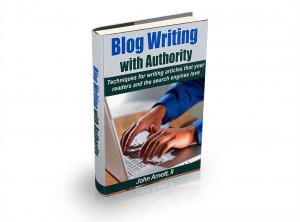 If you spend time on the Internet, you probably already know how important blogging has become. Businesses rely on their blogs as a way to connect with customers and share information about their product. Authors use blogs to show off their expertise and gain a following. Reporters, chefs, politicians and stay-at-home moms alike can become successful bloggers.
If you spend time on the Internet, you probably already know how important blogging has become. Businesses rely on their blogs as a way to connect with customers and share information about their product. Authors use blogs to show off their expertise and gain a following. Reporters, chefs, politicians and stay-at-home moms alike can become successful bloggers.
If you want to show off your expertise, build a brand or simply launch a company that you can manage from the comfort of your home, you should start blogging. Running a blog takes some time and dedication, but getting started is easy. In this guide, I’ll walk you through the steps to launch your first blog. It’s so simple that you can get started today!
Step One: Choose a Topic
The first step to launching a successful blog is knowing what you’re going to say. This may sound a little silly, but it’s worth spending the time to really focus on your goals:
- Why are you blogging? Are you planning to make money with the blog, or do you just want to share your ideas with others? Will this be a full-time job, side-income or a hobby?
- How will you monetize your blog? Will you sell ad space or affiliate products? Will you use the blog to sell your own products?
- Will the blog serve as a way to show your expertise in a field to boost your success in your career?
- What will make your blog different from others in the niche? What will help you stand out?
- Who do you imagine would read the blog? What do they want?
Having a solid content strategy put together in advance is crucial to your success as a blogger. Take the time to research other blogs in your niche before starting so that you have a good idea of what works and what you’d like to do better.
Step Two: Decide Who’s Hosting Your Blog VIDEO
Once you’ve gotten a firm idea of what you’ll be writing about, it’s time to find a blogging platform. You have two options here:
- You can use a free blogging site, like Blogger, which will be simple and free to use but might be too restrictive for professional blogging.
- You can host your own blog using the WordPress platform on a domain that you own. This will cost you some money up-front, but it will be much easier to profit from the blog later.
If you just want to use your blog as a diary for your random thoughts, a free provider is a great service. If you’re going to blog professionally, though, you’ll want the flexibility of a self-hosted blog:
- You’ll own your own domain, rather than a subdomain, so visitors will have an easier time finding the blog.
- You have total control over your content and what ads are run on the page.
- You can monetize the blog without sharing revenue with the hosting page.
- You don’t run the risk of having your blog deleted if the company decides it doesn’t like your content or suddenly cancels its blog service.
To host your blog, you’ll need to buy server space from a web hosting company that is compatible with WordPress. Some popular companies include Domain.com and iPage, but it’s worth shopping around to find a company that offers what you want at a price you’re comfortable with.
Step Three: Purchase a Domain
Every website has its own unique web address, and blogs are no different. If you’re using a free blogging service, your blog’s address will be a sub-domain of whatever company hosts the blog. If you’re hosting your own blog, you’ll need to buy a domain name.
Domains vary in cost depending on their demand, but most will cost around $10 per year. You can register a domain through your hosting company or use Domain.com or a similar service to find and register an available name.
When choosing a name, be sure to pick something easy to spell and remember so that your readers will be able to find their way back to the blog. The easier your blog is to remember, the more likely other people will be to tell their friends about it.
Once you’ve purchased a domain, you’ll need to add it to your web host, which you can do through the dashboard of your hosting account.
Step Four: Install WordPress VIDEO
There are other blogging platforms available for self-hosted websites, but none are as popular or as powerful as WordPress. This program allows you to customize the look of your blog and add text, images and other features without having to code the HTML yourself.
Many webhosting companies offer a one-step WordPress installation. Check your user dashboard to see if there’s a section for plugins, then select the WordPress option if available. You’ll be given the directions for installing and using the program from there. If your webhost does not offer this, you should still be able to use WordPress by downloading it manually and loading it onto your site. Detailed instructions for that process are available here.
Step Five: Customize Your Blog
Once you have WordPress installed, you’ll be able to customize the look and feel of your blog by downloading a theme. Themes are basically a bundle of files that are designed and coded to behave in a certain way. Thousands of themes are available for free, or you can buy premium themes or even order a custom theme from a designer. If you’re feeling ambitious, you can also try your hand at making your own theme, but this will require some knowledge of HTML and CSS coding.
To apply a theme, you’ll first need to download it. You’ll then activate it from within the WordPress dashboard. Special instructions will be included with the theme, so be sure to read over any documents that came with it so that you’ll know how to use it.
WordPress is pretty easy to figure out, but it is so full of features that it might take some time to master. Let yourself experiment with WordPress a little bit, downloading a few themes and modifying files until you feel comfortable and are able to achieve exactly the look you want.
Remember that for most bloggers, simple is better. Some people, like graphic designers, may require a fancier-looking site in order to show off their strengths, but the average blogger is fine with a text-heavy page. In fact, simple designs work better on multiple devices and load quickly, which means that readers will have better access to your message without additional distractions.
Step Six: Start Writing!
Once you’ve settled on a theme that you like and are comfortable with the WordPress platform, it’s time to start writing posts for your blog! Keep your content strategy and goals in mind as you do this. Every post should contribute to your goals and overall vision.
As you start blogging, you’ll want to start learning about more advanced concepts like search engine optimization, analytics, monetization and more. These topics are outside the scope of this simple guide, but they’re easy to learn about with a bit of research. Putting it all to work just requires a bit of practice, but the sooner you start, the more you can hone your craft.
Now that you’ve seen how easy it is to launch a blog, it’s time to make your dreams a reality. Following these steps will allow you to get your blog up and running within a day, setting you on the path toward blogging success!


can you help me set up a blog? I am trying to finish a book on “How I sold my small company and exited smiling”
Yes, Dad. 🙂 I can help you setup your blog. Just go to https://whyistartedablog.com/free-blog-setup/ to get started.
Very detailed and informing. will definitely be applying these steps to my new Blog
Glad I could help. Feel free to “Ask John” with any questions you may have. https://whyistartedablog.com/ask-john/
Started a blog today. First post up. Thanks for bringing this back up and pushing me to start.
This is a nice step by step guide for setting up a wordpress site